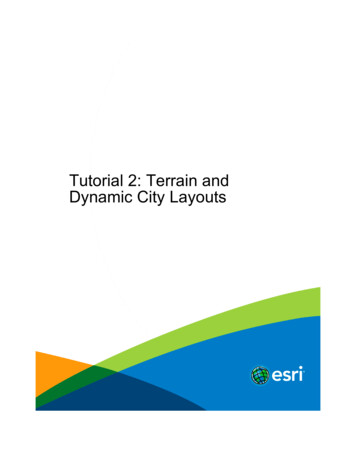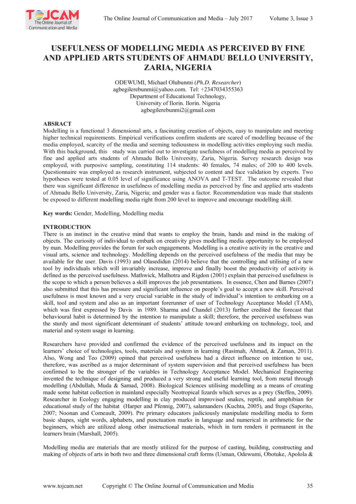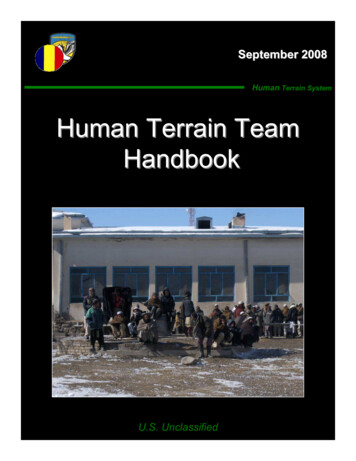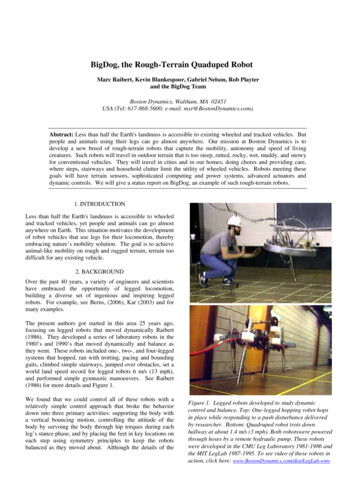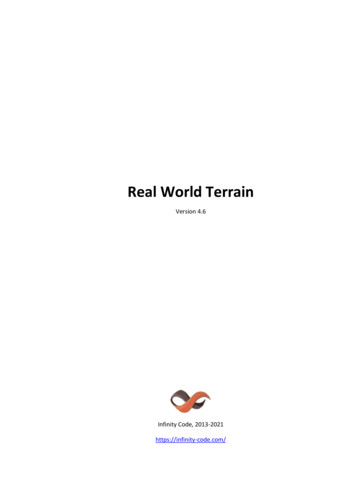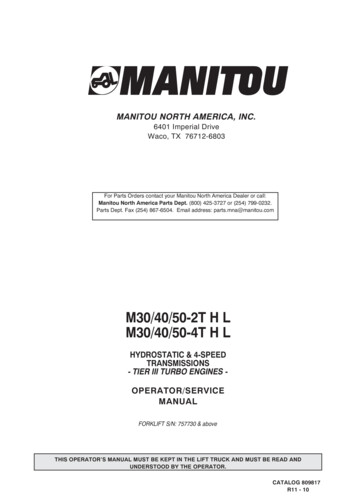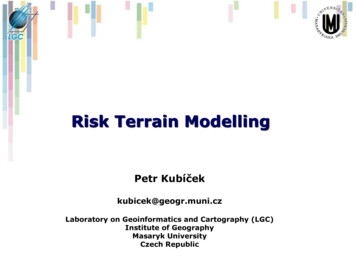
Transcription
Risk Terrain ModellingPetr Kubíčekkubicek@geogr.muni.czLaboratory on Geoinformatics and Cartography (LGC)Institute of GeographyMasaryk UniversityCzech Republic
Predictive Crime Analysis „Predictive policing in the context of placeis the use of historical data to create aspatiotemporal forecast of crime hotspots that will be the basis for police resourceallocation decisions with the expectationthat having officers at the proposed placeand time will deter or detect criminalactivity.“
Risk Terrain ModelingPrediction Risk terrain modeling(RTM) is an approach torisk assessment in whichseparate map layersrepresenting the influenceand intensity of a crimerisk factor at every placethroughout a geography iscreated in a geographicinformation system (GIS). Map layers are combinedto produce a composite“risk terrain” map withvalues that account for allrisk factors at every placethroughout thegeography. Available in PDf – ask yourlecturer
RTM steps1. Select an outcome event of particular interest2. Choose a study area3. Choose a time period4. Obtain base maps of your study area5. Identify aggravating and mitigating factors related tothe outcome event6. Select particular factors to include in the RTM7. Operationalize the spatial influence of factors to riskmap layers8. Weight risk map layers relative to one another9. Combine risk map layers to form a composite map10. Finalize the risk terrain map to communicatemeaningful and actionable information.
Step 1 -21. Select an outcome event of particular interestGun shooting incidents.2. Choose a study area on which risk terrainmaps will be created.The Township of Irvington, NJ.
Step 3STEP 3: Choose a time period to create riskterrain maps for. Six month time period: January 1 to June 30. It is expected that this time period willadequately assess the place‐based risk ofshootings during the next 6‐month time period(July 1 to December 31). Data availability and comparability ? Is itreally justifiable and valid for the CzechRepublic?
Step 4 STEP 4: Obtain basemaps of your studyarea. Two base maps wereobtained from Census2000 TIGER/LineShapefiles:– 1) Polygon shapefile ofthe Township and– 2) Street centerlineshapefile for theTownship.
Step 5aggravating andmitigating risk factors that are related toSTEP 5: Identifythe outcome event. Three aggravating factors were identified based ona review of empirical literature:– dwellings of known gang members (habitualoffenders),– locations of retail business infrastructure (bars,strip clubs, bus stops, check cashing outlets, pawnshops, fast food restaurants, and liquor stores),– locations of drug arrests (places, where the policeaction happened).
Step 6 STEP 6: Select particular risk factors toinclude in the risk terrain model. All three risk factors identified in Step 5 will beincluded. Raw data in tabular form (i.e. Excel spreadsheets)was provided by the Township police and themany datasets they maintain, validate andupdate regularly to support internal crimeanalysis and police investigations. Attributes addresses time stamps ? State of the art of the investigation includingthe punishment and legal procedure.
STEP 7: Operationalizerisk factors to risk maplayers. The tabular data wasgeocoded to streetcenterlines of Irvingtonto create point featuresrepresenting:– the locations of gangmembers’ residences(hiden on the map toprotect the gangmembers),– retail businessoutlets,– and drug arrests,respectively as threeseparate map layers.Step 7
Step 7a – gang memberresidenceThe spatial influence of the “gang members’ residences” risk factorwas operationalized as: “Areas with greater concentrations of gangmembers residing will increase the risk of those places havingshootings.” So, a density map was created from the points of gangmembers’ residences.
Step 7b - infrastructure The spatial influence of the “infrastructure” riskfactor was operationalized as: “High concentrations of bars, strip clubs, busstops, check cashing outlets, pawn shops, fastfood restaurants, and liquor stores will increasethe risk of those dense places having shootings.”
Step 7C – the drug arrestthe “drug arrest” risk factor was operationalized as: “Areas with high concentrations of drug arrestswill be at a greater risk for shootingsbecause these arrests create new ‘open turf’ thatother drug dealers fight over to control.“
Step 7 – map density methoddetails Kernel density values were calculatedfor each of the risk map layers so thatpoints lying near the center of a cellʹssearch area would be weighted moreheavily than those lying near the edge,in effect smoothing the distribution ofvalues. Cells within each density map layer wereclassified into four groups accordingto standard deviational breaks. Thedark blue colored cells had values in thetop five percent of the distribution andwere considered the “highest risk”places.
Step 7d – distance frominfrastructure The spatial influence of the “infrastructure” riskfactor was also operationalized as: “The distance of one block, or about 350ft(app. 100 m), from a facility poses the greatestrisk of shootings because victims are oftentargeted when arriving at or leaving theestablishment.”
7e – final operationalization We are only interested in knowing where placesare the most at risk for shootings, so we used abinary‐valued schema to designate the“highest risk” places across all four risk maplayers. The highest risk places of each risk map layer,respectively, will be given a value of “1”; all otherplaces will be given a value of “0”. All risk factors are operationalized asaggravating factors, so these values willremain positive.
Step 7 - reclassification
Step 7 – final comparison We now have four (final)risk map layers,operationalized from threerisk factors. Binary reclassification – 0 – 1 The cells of different maplayers are the same size andwere classified in a standadway, the risk map layers canbe summed together toform a composite riskterrain map.
Step 8 9 - Inter Risk MapLayer Weighting and CRTMAll risk map layers will carry equal weights to produce anun‐weighted risk terrain model. It is assumed, for example,that being in a place with a high concentration of drug arrestsposes the same risk of having a shooting as being in a placewith a high concentration of gang member residences. Unless weknow better !!
STEP 10 - Finalize the Risk TerrainMap to Communicate MeaningfulInformation. Clip our risk terrain mapto the boundary ofIrvington. produce a final map withshades of grey and layout.
Step 10 – make the risk count convert the risk terrain map from raster to vectorwe can (still using the regular structureconverted to square polygons): count the number of shootings that actuallyoccur in the high‐risk areas during thesubsequent time period; calculate the square area of the highest riskareas (i.e., places with a composite risk value of3);
Step 10 – make the risk count Select all street segments within these areas toinform police commanders about where patrolsmight be increased. Operationalise the command and controll on theday by day basis.
RTM validation Comparison with thesubsequent timeperiod (June 1 –December 31) – highrisk RTM classes andhot spot analysis ofactual shootingaccidents. About 50% (15 out of31) of the shootingsduring the subsequenttime period (July 1 toDecember 31)happened in thesehigh‐risk cluster areas.
Things to remeber Remember, risk terrain modeling is only a toolfor spatial risk assessment; it is not the solutionto crime problems. You (the analyst) give value and meaning toRTM, so be innovative in your thinking about riskfactors and how risk terrain maps can be appliedto police operations.
Melanie Kunz - journal articlesbased PhD thesis INTERACTIVE VISUALIZATIONS OF NATURALHAZARDS DATA AND ASSOCIATEDUNCERTAINTIESETH ZurichSupervised by Lorenzo Hurnibased on five scientific publications anintroductory and a concluding section.The articles are structured in three sections:– Paper 1 and Paper 2 focus on the visualization ofnatural hazards– Paper 3 addresses the visualization ofuncertainties in the field of natural hazards– Paper 4 and Paper 5 finally present the developedprototype and provide feedback of hazardexperts as well as a comparison with existingsystems.
Paper 1How to enhance cartographic visualizations ofnatural hazards assessment results Melanie Kunz & Lorenz Hurni The Cartographic Journal 48(1): 60-71, Abstract : The objective of this research is to offer suggestionsfor enhanced hazard visualizations to facilitate hazardmanagement tasks and decision making. Existingcartographic shortcomings are identified based on anextensive analysis of hazard visualizations and anexpert survey. These shortcomings are discussed andimprovements for important cartographic elementsare presented.
Paper 2Cartographic visualizations of quantitativeassessment results for multiple natural hazards Melanie Kunz, Adrienne Grêt-Regamey & Lorenz Hurni 5th Canadian Conference on Geotechnique andNatural Hazards, 2011, Kelowna, BC, Canada Abstract Cartographic visualizations have proved tobe effective means to communicate these results.However, the large volume of available data, thepresence of multiple natural processes and theheterogeneity of the user group pose visualizationchallenges. In this paper, we analyze results ofnatural hazards assessments and presentcartographic techniques for the visualization ofmultiple natural hazards. In addition, we discusshow interactive cartographic informationsystems can facilitate the communication of hazardrelated data among experts.
Paper 3Visualization of uncertainty in natural hazardsassessments using an interactive cartographicinformation system Melanie Kunz, Adrienne Grêt-Regamey & Lorenz Hurni Natural Hazards, Abstract: Natural hazard assessments are always subject touncertainties due to missing knowledge about thecomplexity of hazardous processes as well as their naturalvariability. Decision makers in the field of natural hazardmanagement need to understand the concept, components,sources, and implications of existing uncertainties in orderto reach informed and transparent decisions. Until now,however, only few hazard maps include uncertaintyvisualizations which would be much needed for anenhanced communication among experts anddecision makers in order to make informed decisionspossible.
Paper 4Customized visualization of natural hazards assessmentresults and associated uncertainties throughinteractivefunctionality Melanie Kunz, Adrienne Grêt-Regamey & Lorenz Hurni Cartography and Geographic Information, 2011 Abstract:The challenge of this research is to overcome these existingshortcomings by combining high quality cartographicvisualizations of natural hazard data as well as associateduncertainties with interactive functionality. In this paper wesummarize requirements that have to be considered, suggestfunctionalities necessary to perform natural hazardsmanagement tasks, and present a prototype of an expertsystem for the visualization and exploration of naturalhazards assessments results and associated uncertainties.
Paper 5Interactive functionality of cartographic informationsystems for natural hazards data – comparison ofselected geoportals with an expert system Melanie Kunz and Lorenz Hurni 25th International Cartographic Conference ICC,2011, Paris, France (LNGandC) Natural hazards assessment results are often presented inform of cartographic visualizations. Due to the advantagesof interactive systems hazard representations areincreasingly integrated in web-based informationsystems. In this paper we give an overview onfunctionality and included data of freely accessibleSwiss Geoportals, compare them to an expertsystem, and finally present how this expert systemcan facilitate natural hazards management tasks.
Predictive Crime Analysis „Predictive policing in the context of place is the use of historical data to create a spatiotemporal forecast of crime hot spots that will be the basis for police resource allocation decisions with the expectation that having officers at the proposed place and time will deter or detect criminal activity."
